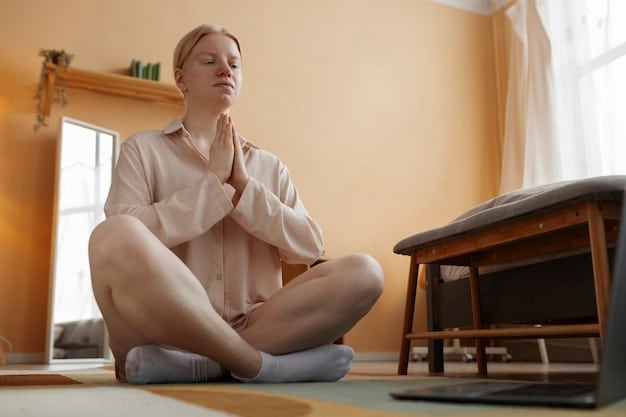Integrate Exercise Daily: Boost Energy & Reduce Stress

Integrating exercise into your daily routine is crucial for boosting energy levels and significantly reducing stress by releasing endorphins and improving overall physical and mental well-being.
Integrating exercise into our daily lives often feels like an insurmountable challenge, especially when juggling work, family, and other commitments. However, the benefits of regular physical activity extend far beyond physical health; it’s a powerful tool for boosting energy and reducing stress. Let’s explore how to integrate exercise into your daily routine seamlessly, making it a sustainable part of your lifestyle and enhancing your overall well-being.
Understanding the Benefits of Daily Exercise
Before diving into the how-to, it’s vital to understand *why* exercise is so important. It’s not just about losing weight or building muscle; the advantages of incorporating physical activity into your daily routine are extensive, impacting both mental and physical health.
Exercise triggers the release of endorphins, natural mood boosters that alleviate pain and reduce stress. It also improves cardiovascular health, strengthens bones and muscles, and enhances sleep quality. Let’s break down some key benefits:
Physical Health Improvements
Regular physical activity strengthens your heart, improves circulation, and helps maintain a healthy weight. It also reduces the risk of chronic diseases like diabetes and heart disease. The impact on your physical well-being is significant and can lead to a longer, healthier life.
Mental Health Benefits
Exercise is a natural stress reliever. It helps to clear your mind, reduce anxiety, and even combat symptoms of depression. The mental clarity and emotional stability that come from regular exercise can significantly improve your daily life.

- Improved Mood: Exercise releases endorphins, which act as natural mood elevators.
- Reduced Stress: Physical activity helps to lower cortisol levels, reducing feelings of stress and anxiety.
- Better Sleep: Regular exercise can improve the quality and duration of your sleep.
Integrating exercise into your daily life offers a comprehensive range of benefits that extend far beyond physical fitness, enhancing both your mental and physical well-being.
Assessing Your Current Routine and Setting Realistic Goals
To effectively integrate exercise, you need to evaluate your current daily routine. Understanding where you can realistically fit physical activity is crucial for setting achievable goals and avoiding burnout.
Start by tracking your activities for a few days. Note when you have pockets of free time, even if it’s just 15-20 minutes. Once you have a clear picture of your schedule, you can begin to identify opportunities for exercise. Some strategies include:
Start Small and Be Consistent
Don’t try to overhaul your entire lifestyle overnight. Start with small, manageable goals, such as 15 minutes of walking each day, and gradually increase the duration and intensity as you get more comfortable.
Be Realistic with Your Goals
Set goals that are challenging but attainable. Trying to do too much too soon can lead to frustration and discouragement. Focus on consistency over intensity – it’s better to exercise for 20 minutes every day than for an hour once a week.
- Identify free time: Look for gaps in your schedule where you can insert short exercise sessions.
- Set specific goals: Define what you want to achieve, such as increasing energy levels or reducing stress.
- Track your progress: Monitor your activity to stay motivated and adjust your goals as needed.
By carefully assessing your current routine and setting realistic goals, you can lay the foundation for a successful and sustainable exercise program.
Simple Exercises to Incorporate Throughout the Day
Integrating exercise doesn’t have to mean spending hours at the gym. Simple exercises, when strategically placed, can significantly improve your day without disrupting your schedule. Short bursts of activity can be surprisingly effective.
Consider these simple exercises that can be easily integrated into your daily routine. Each of these activities requires minimal equipment and can be done almost anywhere. Remember, consistency is key to seeing results and feeling the benefits.
Morning Stretches
Start your day with a few minutes of stretching to increase flexibility and improve circulation. Simple stretches like reaching for the sky or touching your toes can make a big difference in how you feel.
Desk Exercises
If you work at a desk, incorporate simple exercises like leg raises, chair squats, or shoulder rolls throughout the day. These can help combat the negative effects of sitting for long periods and improve your energy levels.

- Walking Meetings: Instead of sitting in a conference room, conduct meetings while walking.
- Stair Climbing: Take the stairs instead of the elevator whenever possible.
- Lunchtime Walks: Use your lunch break to take a brisk walk in the fresh air.
Incorporating these simple exercises throughout your day can have a cumulative effect, improving your energy levels and reducing stress without requiring a significant time commitment.
Turning Everyday Activities into Exercise Opportunities
One of the most effective ways to integrate exercise into your daily routine is to transform everyday activities into opportunities for physical activity. This approach makes exercise more accessible and less of a chore.
Think about the tasks you perform regularly and how you can add a physical element to them. This mindset shift can turn mundane chores into valuable exercise sessions. Remember, every bit of movement counts towards your overall health and well-being.
Walking and Cycling
Opt to walk or cycle for short errands instead of driving. This not only gets you moving but also reduces your carbon footprint. Even a short walk to the grocery store can be a beneficial exercise session.
Active Chores
Turn household chores like gardening, vacuuming, and washing the car into exercise opportunities. These activities involve physical exertion and can help burn calories and improve muscle strength.
Transforming everyday activities into exercise opportunities is an excellent way to naturally increase your physical activity levels without adding extra tasks to your already busy schedule.
Using Technology to Track and Motivate Your Progress
Technology can be a powerful ally in your quest to integrate exercise into your daily routine. Fitness trackers, apps, and online resources can help you track your progress, stay motivated, and discover new ways to stay active.
Wearable fitness trackers can monitor your steps, heart rate, and activity levels, providing valuable data to help you understand your exercise habits. Fitness apps offer guided workouts, personalized exercise plans, and virtual challenges, making exercise more engaging and enjoyable. Some impactful methods include:
Fitness Trackers and Apps
Use fitness trackers to monitor your steps, activity levels, and sleep patterns. Apps can provide personalized workout plans and track your progress toward your fitness goals, offering feedback and encouragement.
Online Resources and Communities
Join online fitness communities to connect with like-minded individuals, share tips and advice, and stay motivated. Online resources, such as YouTube channels and fitness blogs, offer a wealth of information and inspiration for staying active.
- Set Reminders: Use your phone or tracker to set reminders to get up and move throughout the day.
- Join Challenges: Participate in virtual fitness challenges to stay motivated and accountable.
- Track Your Nutrition: Use apps to monitor your diet and ensure you’re fueling your body properly for exercise.
Technology can be a valuable tool for tracking your progress, staying motivated, and discovering new and innovative ways to integrate exercise into your daily routine.
Overcoming Common Barriers and Staying Consistent
Even with the best intentions, integrating exercise into your daily routine can be challenging. Common barriers such as lack of time, motivation, and energy can derail your efforts. However, with the right strategies, you can overcome these obstacles and stay consistent.
It’s important to identify potential barriers and develop strategies to address them proactively. Consistency is key to reaping the long-term benefits of exercise, so finding ways to stay committed is essential. Remember that it’s okay to have setbacks, but the ability to bounce back and keep moving forward is what matters.
Time Management
Schedule exercise into your calendar as you would any other important appointment. Prioritize physical activity and make it a non-negotiable part of your daily routine. Break down your workouts into smaller, manageable chunks if time is a constraint.
Motivation and Accountability
Find an exercise buddy or join a fitness group to stay motivated and accountable. Reward yourself for reaching your fitness goals, and focus on the positive effects of exercise, such as increased energy and reduced stress. Positive reinforcement is a great way to stay committed.
- Find Enjoyable Activities: Choose exercises you genuinely enjoy to make the process more sustainable.
- Prepare in Advance: Lay out your workout clothes and pack your gym bag the night before to streamline your routine.
- Be Flexible: Adjust your routine as needed to accommodate changes in your schedule or energy levels.
By proactively addressing common barriers and implementing effective strategies, you can stay committed to your exercise routine and reap the long-term benefits of physical activity.
| Key Point | Brief Description |
|---|---|
| 💪 Start Small | Begin with short, manageable exercise sessions to build consistency. |
| 🚶 Active Commute | Walk or bike for short errands to turn daily tasks into exercise. |
| 📱 Use Tech | Utilize fitness trackers and apps to monitor progress and stay motivated. |
| 🤝 Find Support | Join a fitness group or find an exercise buddy for accountability. |
Frequently Asked Questions
▼
Aim for at least 30 minutes of moderate-intensity exercise most days of the week. This can be broken down into smaller intervals, such as three 10-minute sessions throughout the day.
▼
Try chair squats, leg raises, desk push-ups, and shoulder rolls. These exercises can be done quickly and discreetly without disrupting your workflow or needing special equipment.
▼
Find activities you enjoy, set realistic goals, track your progress, and reward yourself for reaching milestones. Also, consider finding an exercise buddy for added accountability and motivation.
▼
Yes, it’s fine to exercise daily as long as you vary the intensity and types of activities you do. Be sure to incorporate rest days to allow your body to recover and prevent injuries.
▼
Even short bursts of exercise, such as 10-15 minute sessions, can be beneficial. Focus on making the most of small windows of time throughout the day to accumulate activity.
Conclusion
Incorporating exercise into your daily routine is a manageable and highly beneficial endeavor. By starting small, setting realistic goals, and integrating physical activity into everyday tasks, you can boost your energy, reduce stress, and improve your overall well-being. Remember, the key is consistency and finding activities you enjoy, making exercise a sustainable part of your lifestyle.





